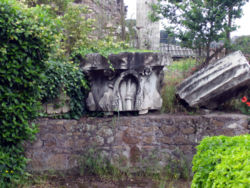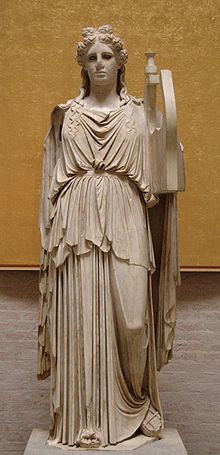
Temple of Apollo Palatinus
Encyclopedia

Palatine Hill
The Palatine Hill is the centermost of the Seven Hills of Rome and is one of the most ancient parts of the city...
of ancient Rome
Ancient Rome
Ancient Rome was a thriving civilization that grew on the Italian Peninsula as early as the 8th century BC. Located along the Mediterranean Sea and centered on the city of Rome, it expanded to one of the largest empires in the ancient world....
, which was first dedicated by Augustus
Augustus
Augustus ;23 September 63 BC – 19 August AD 14) is considered the first emperor of the Roman Empire, which he ruled alone from 27 BC until his death in 14 AD.The dates of his rule are contemporary dates; Augustus lived under two calendars, the Roman Republican until 45 BC, and the Julian...
to his patron god Apollo
Apollo
Apollo is one of the most important and complex of the Olympian deities in Greek and Roman mythology...
. It was only the second temple in Rome dedicated to the god, after the Temple of Apollo Sosianus
Temple of Apollo Sosianus
The Temple of Apollo Sosianus is a Roman temple dedicated to Apollo in the Campus Martius, next to the Theatre of Marcellus and the Porticus Octaviae, in Rome, Italy...
. It was sited next to the main temple in Rome
Temple of Cybele (Palatine)
The Temple of Cybele or Temple of Magna Mater was a temple on the Palatine Hill in Rome. This, the main temple of Cybele or Magna Mater in Rome, was erected after the Roman embassy brought back her icon from Pessinus in 204 BC...
dedicated to Cybele
Cybele
Cybele , was a Phrygian form of the Earth Mother or Great Mother. As with Greek Gaia , her Minoan equivalent Rhea and some aspects of Demeter, Cybele embodies the fertile Earth...
.
History
It was vowed by Octavian in return for the victory over Sextus PompeiusSextus Pompeius
Sextus Pompeius Magnus Pius, in English Sextus Pompey , was a Roman general from the late Republic . He was the last focus of opposition to the Second Triumvirate...
at the Battle of Naulochus
Battle of Naulochus
The naval Battle of Naulochus was fought on 3 September 36 BC between the fleets of Sextus Pompeius and Marcus Vipsanius Agrippa, off Naulochus, Sicily...
in 36 BC and over Mark Antony
Mark Antony
Marcus Antonius , known in English as Mark Antony, was a Roman politician and general. As a military commander and administrator, he was an important supporter and loyal friend of his mother's cousin Julius Caesar...
and Cleopatra at the Battle of Actium
Battle of Actium
The Battle of Actium was the decisive confrontation of the Final War of the Roman Republic. It was fought between the forces of Octavian and the combined forces of Mark Antony and Cleopatra VII. The battle took place on 2 September 31 BC, on the Ionian Sea near the city of Actium, at the Roman...
5 years later
31 BC
Year 31 BC was either a common year starting on Tuesday, Wednesday or Thursday or a leap year starting on Tuesday or Wednesday of the Julian calendar and a common year starting on Tuesday of the Proleptic Julian calendar...
, and was built on a site where a lightning bolt had struck the interior of Augustus' property on the Palatine. It was dedicated on October 9 of 28 BC. The ludi saeculares, reinstituted by Augustus in 17 BC and also largely developed and funded by him, involved the new temple.
Augustus' private house
House of Augustus
The House of Augustus, or the Domus Augusti, is the first major site upon entering the Palatine Hill in Rome, Italy. It served as the primary residence of Caesar Augustus during his reign...
was directly connected to the terrace of the sanctuary via frescoed halls and corridors. This tight connection between the sanctuary and the house of the princeps
Princeps
Princeps is a Latin word meaning "first in time or order; the first, chief, the most eminent, distinguished, or noble; the first man, first person."...
, both dominating the Circus Maximus
Circus Maximus
The Circus Maximus is an ancient Roman chariot racing stadium and mass entertainment venue located in Rome, Italy. Situated in the valley between the Aventine and Palatine hills, it was the first and largest stadium in ancient Rome and its later Empire...
, repeated a trope already present in royal palaces of Hellenistic dynasties.
Description

Circus Maximus
The Circus Maximus is an ancient Roman chariot racing stadium and mass entertainment venue located in Rome, Italy. Situated in the valley between the Aventine and Palatine hills, it was the first and largest stadium in ancient Rome and its later Empire...
. The temple's precinct (the area Apollinis) was an artificial terrace (70 x 30 m), supported on opus quadratum
Opus quadratum
Opus quadratum is an ancient Roman construction technique, in which squared blocks of stone of the same height were set in parallel courses, often without the use of mortar.-Technique:...
sub-structures. It contained an altar faced with the sculptural group "Myron
Myron
Myron of Eleutherae working circa 480-440 BC, was an Athenian sculptor from the mid-5th century BC. He was born in Eleutherae on the borders of Boeotia and Attica. According to Pliny's Natural History, Ageladas of Argos was his teacher....
's Herd", sited together on an elaborate base. In the northern part of this terrace the temple was raised on a high podium, built in blocks of tufa
Tuff
Tuff is a type of rock consisting of consolidated volcanic ash ejected from vents during a volcanic eruption. Tuff is sometimes called tufa, particularly when used as construction material, although tufa also refers to a quite different rock. Rock that contains greater than 50% tuff is considered...
and travertine
Travertine
Travertine is a form of limestone deposited by mineral springs, especially hot springs. Travertine often has a fibrous or concentric appearance and exists in white, tan, and cream-colored varieties. It is formed by a process of rapid precipitation of calcium carbonate, often at the mouth of a hot...
in the load-bearing parts and elsewhere in cement. The temple itself was in blocks of Carrara marble, with a pronaos as well as a facade of full columns on the front and the same order continued on half columns against the outside walls of the cella
Cella
A cella or naos , is the inner chamber of a temple in classical architecture, or a shop facing the street in domestic Roman architecture...
.
In the excavations different polychromatic terracotta slabs were recovered with reliefs of mythological subjects (of the "lastre Campana" type).
The adjoining library (bibliotheca Apollinis), according to the Forma Urbis Romae
Forma Urbis Romae
The Forma Urbis Romae or Severan Marble Plan is a massive marble map of ancient Rome, created under the emperor Septimius Severus between 203 and 211...
, was constituted from two apsidal halls, with the walls decorated by a row of columns.
Sculptures
The ancient sources state the temple had ivory doors and held numerous works of sculpture. The pediment included two bas-reliefs of hunting the GalatiaGalatia
Ancient Galatia was an area in the highlands of central Anatolia in modern Turkey. Galatia was named for the immigrant Gauls from Thrace , who settled here and became its ruling caste in the 3rd century BC, following the Gallic invasion of the Balkans in 279 BC. It has been called the "Gallia" of...
ns, from Delphi
Delphi
Delphi is both an archaeological site and a modern town in Greece on the south-western spur of Mount Parnassus in the valley of Phocis.In Greek mythology, Delphi was the site of the Delphic oracle, the most important oracle in the classical Greek world, and a major site for the worship of the god...
, and 6th century BC Chian
Chios
Chios is the fifth largest of the Greek islands, situated in the Aegean Sea, seven kilometres off the Asia Minor coast. The island is separated from Turkey by the Chios Strait. The island is noted for its strong merchant shipping community, its unique mastic gum and its medieval villages...
art, with sculptures of the Niobids
Niobids
In Greek mythology, the Niobids were the children of Amphion of Thebes and Niobe, slain by Apollo and Artemis because Niobe, born of the royal house of Phrygia, had boastfully compared the greater number of her own offspring with those of Leto, Apollo's and Artemis' mother: a classic example of...
by Bupalus and Athenis
Bupalus
Bupalus and Athenis , were sons of Archermus, and members of the celebrated school of sculpture in marble which flourished in Chios in the 6th century BC. They were contemporaries of the poet Hipponax, whom they were said to have caricatured...
. The cult group in the cella included a statue of Apollo Citharoedus
Apollo Citharoedus
An Apollo Citharoedus, or Apollo Citharede, designates a statue or other image of Apollo with cithara . Among the best-known realizations of this aspect of Apollo is the Apollo Citharoedus of the Vatican Museums, a 2nd century AD colossal marble statue of by an unknown Roman sculptor...
, possibly by Scopas
Scopas
Scopas or Skopas was an Ancient Greek sculptor and architect, born on the island of Paros. Scopas worked with Praxiteles, and he sculpted parts of the Mausoleum of Halicarnassus, especially the reliefs. He led the building of the new temple of Athena Alea at Tegea...
and perhaps from the sanctuary of Apollo at Rhamnus in Attica; a sculpture of Diana, by Timotheos
Timotheos
Timotheus was a Greek sculptor of the 4th century BC, one of the rivals and contemporaries of Scopas of Paros, among the sculptors who worked for their own fame on the construction of the grave of Mausolus at Halicarnassus between 353 and 350 BC. He was apparently the leading sculptor at the...
; and one of Latona, sculpted by Cephisodotus
Cephisodotus
Cephisodotus may refer to:*Cephisodotus , the Athenian general and statesman*Cephisodotus the Elder, sculptor, the father of the sculptor Praxiteles*Cephisodotus the Younger, sculptor, the son of the sculptor Praxiteles...
. Into shelves at the basis of the statue of Apollo were placed the Sibylline Books
Sibylline Books
The Sibylline Books or Libri Sibyllini were a collection of oracular utterances, set out in Greek hexameters, purchased from a sibyl by the last king of Rome, Tarquinius Superbus, and consulted at momentous crises through the history of the Republic and the Empire...
, transferred here from the temple of Jupiter on the Capitol (cf. Suetonius
Suetonius
Gaius Suetonius Tranquillus, commonly known as Suetonius , was a Roman historian belonging to the equestrian order in the early Imperial era....
, Div. Aug. 31.3).
The temple was surrounded by a portico (the portico of the Danaids) with columns in yellow 'giallo antico' marble, and with black marble statues of the fifty Danaids in between the column-shafts, a sculpture of Danaos with his sword unsheathed, and equestrian statues of the sons of Egypt.

